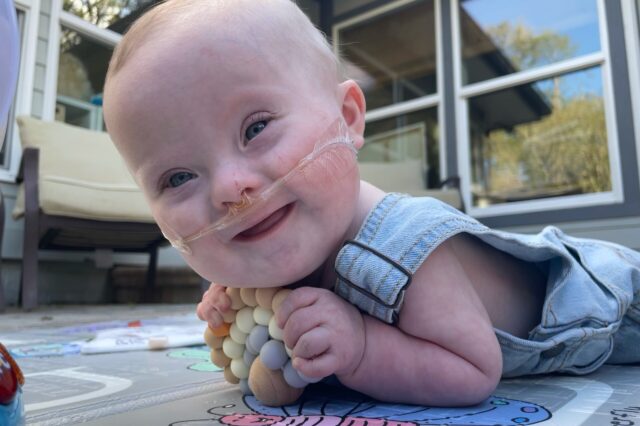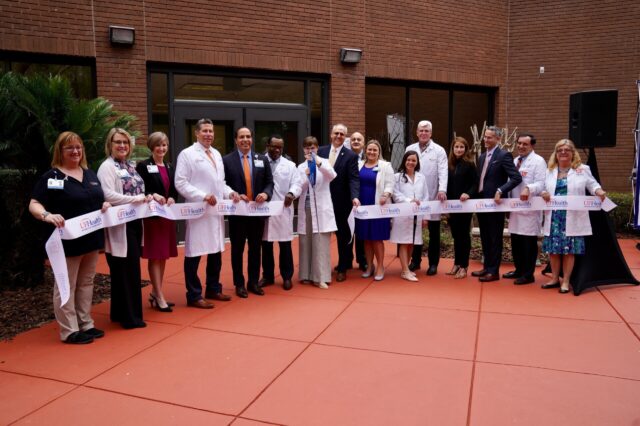The Brantleys and the story of BrAvery
Avery looked up as his mom and dad took turns reading Curious George. Each page made the presence of Averys monitors and tubes slip further from the Brantleys…

Update your location to show providers, locations, and services closest to you.
Down syndrome is a genetic condition in which a person has 47 chromosomes instead of the usual 46.
Trisomy 21
In most cases, Down syndrome occurs when there is an extra copy of chromosome 21. This form of Down syndrome is called trisomy 21. The extra chromosome causes problems with the way the body and brain develop.
Down syndrome is one of the most common causes of birth defects.
Down syndrome symptoms vary from person to person and can range from mild to severe. No matter how severe the condition is, people with Down syndrome have a widely-recognized appearance.
The head may be smaller than normal and abnormally shaped. For example, the head may be round with a flat area on the back. The inner corner of the eyes may be rounded instead of pointed.
Common physical signs include:
Physical development is often slower than normal. Most children with Down syndrome never reach average adult height.
Children may also have delayed mental and social development. Common problems may include:
As children with Down syndrome grow and become aware of their limitations, they may also feel frustration and anger.
Many different medical conditions are seen in people with Down syndrome, including:
A doctor can often make a diagnosis of Down syndrome at birth based on how the baby looks. The doctor may hear a heart murmur when listening to the baby's chest with a stethoscope.
A blood test can be done to check for the extra chromosome and confirm the diagnosis.
Other tests that may be done include:
People with Down syndrome need to be closely screened for certain medical conditions. They should have:
There is no specific treatment for Down syndrome. If treatment is needed, it is usually for associated health problems. For example, a child born with a gastrointestinal blockage may need major surgery right after birth. Certain heart defects may also require surgery.
When breast-feeding, the baby should be well supported and fully awake. The baby may have some leakage because of poor tongue control. But many infants with Down syndrome can successfully breastfeed.
Obesity can become a problem for older children and adults. Getting plenty of activity and avoiding high-calorie foods are important. Before beginning sports activities, the child's neck and hips should be examined.
Behavioral training can help people with Down syndrome and their families deal with the frustration, anger, and compulsive behavior that often occur. Parents and caregivers should learn to help a person with Down syndrome deal with frustration. At the same time, it is important to encourage independence.
Teen girls and women with Down syndrome are usually able to get pregnant. There is an increased risk for sexual abuse and other types of abuse in both males and females. It is important for those with Down syndrome to:
If the person has any heart defects or other heart problems, antibiotics may need to be prescribed to prevent a heart infection called endocarditis.
Special education and training are offered in most communities for children with delays in mental development. Speech therapy may help improve language skills. Physical therapy may teach movement skills. Occupational therapy may help with feeding and performing tasks. Mental health care can help both parents and the child manage mood or behavior problems. Special educators are also often needed.
More information and support for people with Down syndrome and their families can be found at:
Although many children with Down syndrome have physical and mental limitations, they can live independent and productive lives well into adulthood.
About one half of children with Down syndrome are born with heart problems, including atrial septal defect, ventricular septal defect, and endocardial cushion defects. Severe heart problems may lead to early death.
People with Down syndrome have an increased risk for certain types of leukemia, which can also cause early death.
The level of intellectual disability varies, but is usually moderate. Adults with Down syndrome have an increased risk for dementia.
A health care provider should be consulted to determine if the child needs special education and training. It is important for the child to have regular checkups with a doctor.
Experts recommend genetic counseling for people with a family history of Down syndrome who wish to have a baby.
A woman's risk of having a child with Down syndrome increases as she gets older. The risk is significantly higher among women age 35 and older.
Couples who already have a baby with Down syndrome have an increased risk of having another baby with the condition.
Tests such as nuchal translucency ultrasound, amniocentesis, or chorionic villus sampling can be done on a fetus during the first few months of pregnancy to check for Down syndrome.
Bacino CA, Lee B. Cytogenetics. In: Kliegman RM, St. Geme JW, Blum NJ, Shah SS, Tasker RC, Wilson KM, eds. Nelson Textbook of Pediatrics. 21st ed. Philadelphia, PA: Elsevier; 2020:chap 98.
Centers for Disease Control and Prevention website. Birth defects: facts about down syndrome. www.cdc.gov/ncbddd/birthdefects/downsyndrome.html. Updated April 6, 2021. Accessed June 15, 2021.
Cooke DW, DiVall SA, Radovick S. Normal and aberrant growth in children. In: Melmed S, Auchus, RJ, Goldfine AB, Koenig RJ, Rosen CJ, eds. Williams Textbook of Endocrinology. 14th ed. Philadelphia, PA: Elsevier; 2020:chap 25.
Driscoll DA, Simpson JL. Genetic screening and diagnosis. In: Landon MB, Galan HL, Jauniaux ERM, et al, eds. Gabbe's Obstetrics: Normal and Problem Pregnancies. 8th ed. Philadelphia, PA: Elsevier; 2021:chap 10.



Our community and patient programs provide great value to patients, families and loved ones. People can find support, educational materials, expert consultants and more. In most instances, these programs are offered free of charge.
Provides a range of services: diagnostic evaluation and consultation for children and youth who have complex medical, educational, emotional and/or behavioral problems.
Avery looked up as his mom and dad took turns reading Curious George. Each page made the presence of Averys monitors and tubes slip further from the Brantleys…

February 20, 2020
For more information, please contact Ken Garcia at kdgarcia@ufl.edu or 352-273-9799. University of Florida Health today cut the ribbon on its new Center for…
UF Health Shands Hospital, UF Health Shands Rehab Hospital, +2 more

Scientists have developed a new blood test that can help pregnant woman at risk for having a baby with Down syndrome avoid procedures that carry a risk of miscarriage. The new test analyzes the...
People with Down syndrome are prone to certain health...
For decades, conventional wisdom held that pregnant women thirty-five and older were the only ones who needed testing for Down...